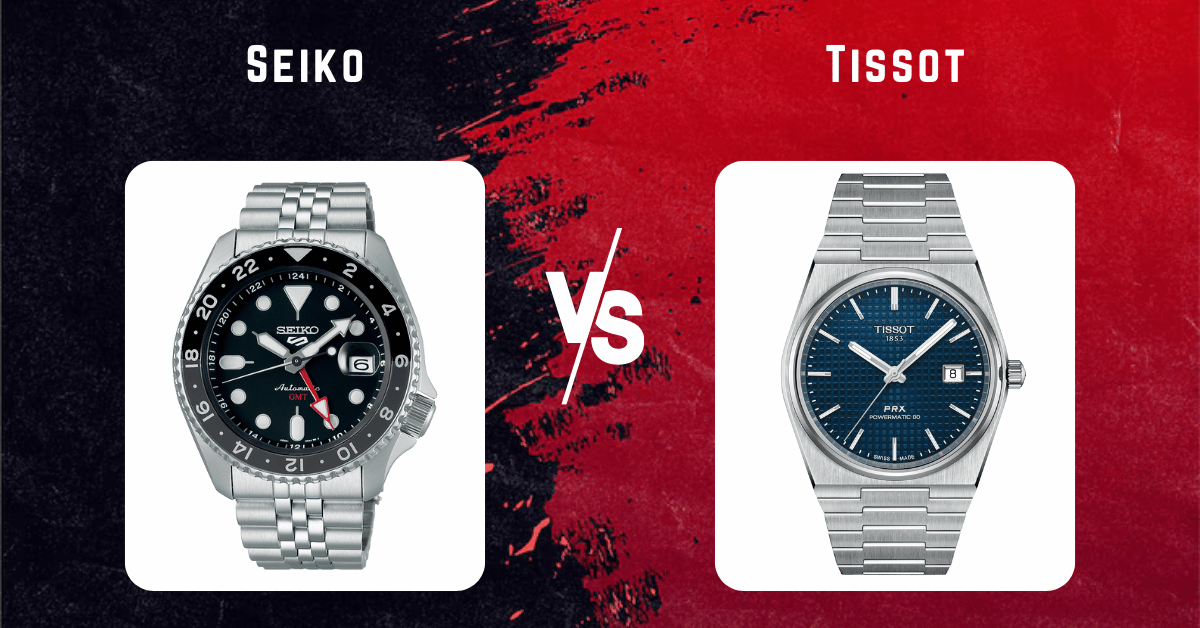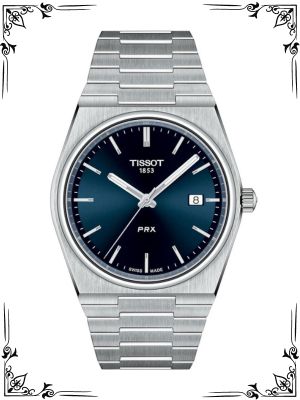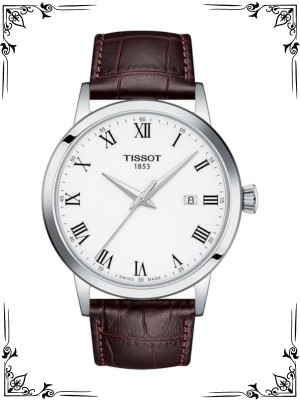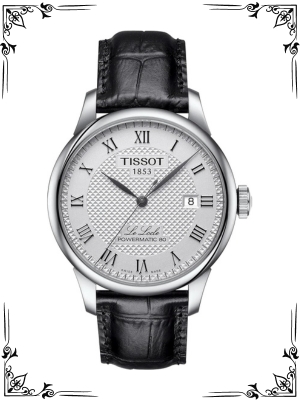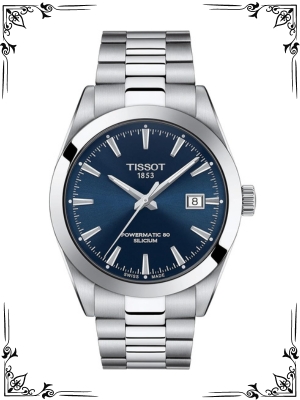When it comes to choosing a watch, the decision can often be overwhelming due to the plethora of options available. Among the many brands that dominate the market, Seiko and Tissot stand out as two of the most reputable and admired names.
Whether you are a seasoned watch collector or someone looking to purchase your first high-quality timepiece, understanding the differences and similarities between Seiko and Tissot can help you make an informed decision.
In this guide, we will dive deep into the histories, innovations, design philosophies, and key features of Seiko and Tissot. By the end of this article, you will have a clear understanding of which brand might be the best fit for your wrist.
A Brief History of Seiko and Tissot
Seiko: Pioneers in Watchmaking
Seiko’s journey began in 1881 when Kintaro Hattori opened a shop selling and repairing watches and clocks in Tokyo, Japan. The company officially became known as Seiko in 1924 when it produced its first wristwatch. Seiko has since become synonymous with innovation in the watch industry.
The brand introduced the world’s first quartz watch, the Seiko Quartz Astron, in 1969, revolutionizing timekeeping with unprecedented accuracy. Seiko continued to lead the way with advancements such as the first kinetic watch in 1988, which converted kinetic energy into electrical energy to power the watch.
Tissot: Swiss Excellence
Tissot was founded in 1853 by Charles-Félicien Tissot and his son, Charles-Émile Tissot, in the small Swiss town of Le Locle. Tissot quickly gained a reputation for high-quality, innovative watches. One of their early milestones was the creation of the first mass-produced pocket watch in 1853 and the first pocket watch with two time zones.
Tissot has always been at the forefront of technological advancements, including the production of the first anti-magnetic watch in 1930 and the introduction of the revolutionary T-Touch technology in 1999, which features a touch-sensitive sapphire crystal for interactive functions.
Innovations and Technologies
Seiko’s Technological Triumphs
Seiko has a long history of technological innovation that has set it apart from its competitors. Some of the brand’s notable technologies include:
Quartz Movement: Seiko’s introduction of the quartz movement in 1969 was a game-changer for the watch industry. Quartz watches are known for their exceptional accuracy, with deviations of only a few seconds per month compared to mechanical watches.
Spring Drive: Launched in 1999, the Spring Drive is a unique movement that combines the best of mechanical and quartz technologies. It offers the precision of quartz with the smooth, sweeping second hand of a mechanical watch.
Kinetic Movement: Seiko’s Kinetic watches, introduced in 1988, convert the wearer’s kinetic energy into electrical energy, eliminating the need for battery replacements.
Solar Power: Seiko’s solar-powered watches harness light energy, both natural and artificial, to charge the watch, providing a sustainable and convenient power source.
Tissot’s Technological Mastery
Tissot has also been a pioneer in watchmaking technology, with several notable innovations:
T-Touch Technology: Introduced in 1999, T-Touch watches feature a touch-sensitive sapphire crystal that allows the wearer to access various functions such as a compass, altimeter, and thermometer by tapping on the watch face.
Powermatic 80: This automatic movement, introduced in 2013, offers an impressive 80-hour power reserve, significantly longer than the standard 40-hour reserve found in most automatic watches.
Silicium Technology: Tissot has incorporated silicon balance springs in some of their movements, which enhances accuracy and reduces the need for maintenance due to its anti-magnetic properties.
Heritage Models: Tissot often revives historical designs with modern technology, combining vintage aesthetics with contemporary watchmaking advancements.
Design and Aesthetics
Seiko’s Diverse Designs
Seiko’s design philosophy emphasizes both functionality and elegance, catering to a wide range of tastes and preferences. Whether you prefer a classic dress watch, a robust dive watch, or a sophisticated chronograph, Seiko has something to offer.
Dress Watches: Seiko’s dress watches, such as the Seiko Presage line, are known for their timeless elegance and attention to detail. These watches often feature clean, minimalist dials with subtle textures and high-quality materials like stainless steel and leather.
Dive Watches: Seiko’s dive watches, including the iconic Seiko Prospex series, are renowned for their durability and performance. These watches are equipped with features like high water resistance, luminous hands and markers, and robust cases to withstand underwater adventures.
Chronographs: Seiko’s chronograph watches, like the Seiko Astron series, combine advanced functionality with sleek design. These watches often feature multiple sub-dials, tachymeter scales, and intricate details that appeal to those who appreciate technical complexity.
Tissot’s Swiss Elegance
Tissot’s design ethos is rooted in Swiss tradition, blending classic elegance with modern flair. The brand offers a diverse range of styles, from sporty chronographs to refined dress watches.
Classic Watches: Tissot’s classic watches, such as the Tissot Le Locle series, embody timeless sophistication. These watches often feature Roman numerals, guilloché dials, and elegant leather straps, making them perfect for formal occasions.
Sporty Watches: Tissot’s sporty watches, including the Tissot PRS 516 and the Tissot T-Race series, are designed for active lifestyles. These watches boast features like tachymeters, chronographs, and durable materials like stainless steel and silicone.
Heritage Models: Tissot’s heritage models, such as the Tissot Heritage Visodate, pay homage to the brand’s rich history. These watches blend vintage-inspired designs with modern technology, creating a nostalgic yet contemporary appeal.
Key Features and Comparisons
To help you better understand the differences and similarities between Seiko and Tissot, let’s compare some key features side by side:
Movements
| Feature | Seiko | Tissot |
|---|---|---|
| Movement Types | Quartz, Mechanical, Spring Drive, Kinetic | Quartz, Mechanical, Powermatic 80, Silicium |
| Accuracy | Highly accurate, especially quartz and Spring Drive | Accurate, particularly with Powermatic 80 and quartz |
| Innovation | Pioneered quartz, Spring Drive, Kinetic movements | Pioneered T-Touch technology and Powermatic 80 movement |
Design and Aesthetics
| Feature | Seiko | Tissot |
|---|---|---|
| Design Variety | Wide range from dress to dive to chronographs | Wide range from classic to sporty to heritage models |
| Material Quality | High-quality materials like stainless steel and sapphire crystal | High-quality materials like stainless steel, sapphire crystal, and leather |
| Unique Styles | Emphasis on functionality and elegance | Emphasis on Swiss tradition and modern flair |
Price Range
| Feature | Seiko | Tissot |
|---|---|---|
| Entry-Level | $100 – $300 | $200 – $400 |
| Mid-Range | $300 – $1,000 | $400 – $1,500 |
| High-End | $1,000+ | $1,500+ |
Durability and Maintenance
| Feature | Seiko | Tissot |
|---|---|---|
| Durability | Durable construction with a focus on precision | Durable construction with focus on precision |
| Maintenance | Generally low maintenance, especially quartz and kinetic models | Regular maintenance recommended, especially for mechanical models |
Seiko: Popular Models and Series
Seiko Prospex: The Seiko Prospex series is renowned for its robust and reliable dive watches. Popular models include:
- Seiko Prospex Turtle: Known for its cushion-shaped case, the Turtle is a favorite among divers for its durability and legibility underwater.
- Seiko Prospex Samurai: Featuring a sharp, angular design, the Samurai is loved for its rugged look and reliable performance.
Seiko Presage: The Seiko Presage series offers elegant dress watches with a focus on traditional craftsmanship and fine details. Popular models include:
- Seiko Presage Cocktail Time: Inspired by cocktails, these watches feature stunning dial colors and textures, making them perfect for formal occasions.
- Seiko Presage Automatic: These models combine classic design elements with automatic movements, offering a blend of tradition and modernity.
Seiko Astron: The Seiko Astron series is known for its advanced GPS solar technology, allowing the watch to adjust to any time zone with precision. Popular models include:
- Seiko Astron GPS Solar: This model offers incredible accuracy by syncing with GPS satellites and is powered by light, eliminating the need for battery changes.
Seiko 5: The Seiko 5 series is beloved for its affordability and reliability. These watches are often the first choice for those new to automatic watches. Popular models include:
- Seiko 5 Sports: With a wide range of designs, these watches offer great value with their automatic movements and robust construction.
Tissot: Popular Models and Series
Tissot Le Locle: The Tissot Le Locle series is named after the brand’s home in Switzerland and represents classic Swiss watchmaking. Popular models include:
- Tissot Le Locle Automatic: Known for its elegant design with Roman numerals and guilloché dials, this model is perfect for formal wear.
Tissot PRS 516: The Tissot PRS 516 series is inspired by motorsport, offering sporty and dynamic designs. Popular models include:
- Tissot PRS 516 Automatic Chronograph: This model features a tachymeter scale and chronograph functions, making it a favorite among sports enthusiasts.
Tissot T-Touch: The Tissot T-Touch series incorporates cutting-edge touch technology, allowing the wearer to access various functions through the watch’s sapphire crystal. Popular models include:
- Tissot T-Touch Expert Solar: This model offers features such as a compass, altimeter, and barometer, all powered by solar energy.
Tissot Seastar: The Tissot Seastar series is designed for divers, offering high water resistance and durable construction. Popular models include:
- Tissot Seastar 1000: With its impressive water resistance and stylish design, the Seastar 1000 is a favorite among diving enthusiasts.
Tissot Heritage: The Tissot Heritage series pays homage to the brand’s rich history, combining vintage-inspired designs with modern technology. Popular models include:
- Tissot Heritage Visodate: Featuring a classic design with a date function, this model is a nod to Tissot’s historical pieces.
Summary of Popular Models and Series
| Brand | Series | Popular Models | Key Features |
|---|---|---|---|
| Seiko | Prospex | Turtle, Samurai | Robust dive watches, high water resistance, durable construction |
| Presage | Cocktail Time, Automatic | Elegant dress watches, detailed dials, automatic movements | |
| Astron | GPS Solar | Advanced GPS solar technology, adjusts to any time zone | |
| Seiko 5 | Sports | Affordable, reliable automatic watches, wide range of designs | |
| Tissot | Le Locle | Automatic | Classic Swiss design, Roman numerals, guilloché dials |
| PRS 516 | Automatic Chronograph | Motorsport-inspired, chronograph functions, tachymeter scale | |
| T-Touch | Expert Solar | Touch technology, compass, altimeter, solar-powered | |
| Seastar | 1000 | High water resistance, stylish dive watches | |
| Heritage | Visodate | Vintage-inspired design, modern technology, date function |
By exploring these popular models and series, you can find the perfect Seiko or Tissot watch that aligns with your style, needs, and budget. Whether you are drawn to the innovation and variety of Seiko or the elegance and tradition of Tissot, both brands offer exceptional timepieces that will enhance any watch collection.
Seiko vs. Tissot: Which is Right for You?
Choosing between Seiko and Tissot ultimately depends on your personal preferences, budget, and the specific features you value in a watch. Here are some scenarios to help you decide:
If You Value Innovation and Technology
Seiko might be the better choice if you appreciate groundbreaking technology and innovation. The brand’s history of pioneering quartz, kinetic, and Spring Drive movements demonstrates its commitment to pushing the boundaries of watchmaking. Seiko’s solar-powered watches also appeal to those who prefer environmentally friendly options.
If You Prefer Swiss Tradition and Elegance
Tissot is an excellent choice if you are drawn to Swiss watchmaking heritage and timeless elegance. The brand’s classic designs and attention to detail reflect the Swiss tradition of precision and craftsmanship. Tissot’s heritage models offer a nostalgic charm, combining vintage aesthetics with modern reliability.
If You Are Looking for Robust Dive Watches
Seiko is renowned for its dive watches, making it the go-to brand for underwater enthusiasts. The Seiko Prospex series, with its high water resistance, luminous hands, and durable construction, is ideal for diving and other aquatic activities.
If You Want a Stylish Dress Watch
Both Seiko and Tissot offer elegant dress watches, but Tissot’s classic designs might have a slight edge for formal occasions. The Tissot Le Locle series, with its Roman numerals and guilloché dials, exudes sophistication and is perfect for a refined look.
If You Have a Limited Budget
Seiko generally offers a wider range of affordable options, making it more accessible for those with a limited budget. The brand’s entry-level and mid-range watches provide excellent value for money without compromising on quality and features.
If You Appreciate Modern Features
Tissot’s T-Touch technology offers modern functionalities such as a compass, altimeter, and thermometer, appealing to tech-savvy individuals. If you enjoy interactive features and advanced technology, the Tissot T-Touch series might be the right fit for you.
Conclusion
Both Seiko and Tissot are exceptional watch brands with rich histories, innovative technologies, and a diverse range of designs. Seiko excels in technological advancements and offers robust dive watches, while Tissot shines with its Swiss tradition, elegant designs, and modern features.
Ultimately, the choice between Seiko and Tissot comes down to your personal preferences, lifestyle, and budget.
When making your decision, consider what aspects of a watch are most important to you—whether it’s cutting-edge technology, timeless elegance, or durability. Whichever brand you choose, you can be confident that you are investing in a high-quality timepiece that will stand the test of time.
Frequently Asked Questions
What are the main differences between Seiko and Tissot watches?
The main differences between Seiko and Tissot watches lie in their origins, innovations, and design philosophies. Seiko, a Japanese brand, is known for its technological advancements such as quartz, kinetic, and Spring Drive movements.
Tissot, a Swiss brand, emphasizes traditional Swiss craftsmanship and elegance, with innovations like T-Touch technology and Powermatic 80 movements.
Are Seiko watches more accurate than Tissot watches?
Seiko watches, especially those with quartz and Spring Drive movements, are renowned for their accuracy. Quartz movements can have deviations of only a few seconds per month, while Spring Drive movements combine the precision of quartz with the beauty of mechanical movements.
Tissot watches with quartz movements and the Powermatic 80 movement also offer excellent accuracy, with the Powermatic 80 providing an impressive 80-hour power reserve.
Which brand offers better value for money, Seiko or Tissot?
Both Seiko and Tissot offer great value for money, but Seiko generally provides a wider range of affordable options, especially in the entry-level and mid-range segments. Seiko’s watches are known for their quality and reliability at competitive prices.
Tissot, while slightly more expensive, offers excellent value through its Swiss craftsmanship and innovative features.
Are Seiko and Tissot watches suitable for formal occasions?
Yes, both Seiko and Tissot offer watches that are suitable for formal occasions. Seiko’s dress watches, such as the Seiko Presage series, feature elegant designs and high-quality materials. Tissot’s classic watches, like the Tissot Le Locle series, are known for their sophistication and timeless appeal, making them perfect for formal settings.
How often should I service my Seiko or Tissot watch?
The frequency of servicing depends on the type of movement and the watch’s usage. Quartz watches from both brands typically require minimal maintenance, with battery replacements every few years.
Mechanical watches, including automatic and manual-wind models, should be serviced approximately every 3 to 5 years to ensure optimal performance. Always refer to the manufacturer’s recommendations for specific maintenance guidelines.
Choosing between Seiko and Tissot is a matter of personal preference, and both brands have much to offer. Whether you prioritize technological innovation, Swiss tradition, or a combination of both, you can find a watch that meets your needs and complements your style.

